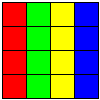
This sample program shows how palette changes can create an animated effect.
Source: (SDK root)\Samples\Multimedia\DDraw\Src\Wormhole
Executable: (SDK root)\Samples\Multimedia\DDraw\Bin
Press F12 or ESC to quit the program.
Imagine a 4x4 display using 4 colors. We could set the colors up to look something like this:

Now we can cycle all of the colors in each row to the right. The one on the right will wrap-around to the left.
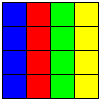
If we continue this cycling we would get animated lines moving to the right. The same can be done to animate the lines going down:
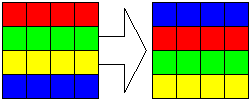
Now if we expand our palette to 16 color we can combine moving down and right at the same time.
Move right:
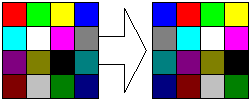
Move down:
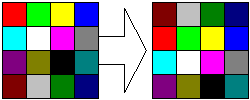
Move right and down:

Now if you tile these 4x4 blocks end to end and cycle the colors as above, you get a moving checkerboard. Wormhole does the same thing, except that it uses 15x15 blocks (225 colors) and instead of tiling the blocks end to end on a flat plane, it tiles them in 3-D converging at the center of the wormhole.
The following code will generate the 3-D wormhole using the aforementioned 15x15 grids:
//Do all the work!
//convert r,theta,z to x,y,x to screen x,y
//plot the point
//z=-1.0+(log(2.0*j/DIVS) is the line that sets the math eqn for plot
//Feel free to try other functions!
//Cylindrical coordinates, e.g. z=f(r,theta)
#define STRETCH 25
#define PI 3.14159265358979323846
#define XCENTER 160
#define YCENTER 50
#define DIVS 1200
#define SPOKES 2400
void transarray(void)
{
float x,y,z;
int i,j,color;
for(j=1;j<DIVS+1;j++)
for(i=0;i<SPOKES;i++)
{
z=-1.0+(log(2.0*j/DIVS));
x=(320.0*j/DIVS*cos(2*PI*i/SPOKES));
y=(240.0*j/DIVS*sin(2*PI*i/SPOKES));
y=y-STRETCH*z;
x+=XCENTER;
y+=YCENTER;
color=((i/8)%15)+15*((j/6)%15)+1;
if ((x>=0)&&(x<=320)&&(y>=0)&&(y<=200))
plot((int) x,(int) y,color);
}
}
After loading the bitmap to a DirectDraw surface, all that is left to do is rotate the colors and you have a wormhole.